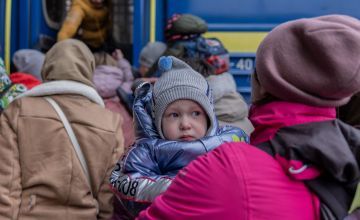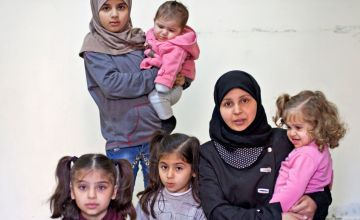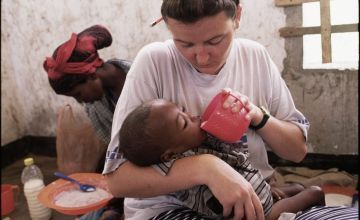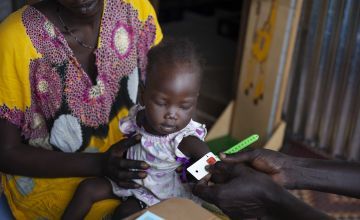
Read our 2024 annual report

Knowledge Hub
Conflict has been the rule rather than the exception for most of our history.
In fact, historians Will and Ariel Durant note that humans have been entirely at peace for just 268 years out of all recorded history (ancient and modern).
While conflict is devastating for everyone involved, it has a harder impact on certain people. Among those hit hardest are children. Here are 10 ways that war affects children’s lives, along with some key facts and figures.
1. War shifts family dynamics
We’ll get to displacement in a moment, but regardless of whether a family stays together at home, moves together in search of refuge, a move that’s closer to something in between, or the loss of family and friends due to violence, war fundamentally changes family dynamics. This can be even more traumatising for children, who rely on a stable home life for their proper emotional growth and development.
The ongoing crisis in Ukraine is a recent example: Men, with very little exception, have been denied passage out of the country on trains and buses and are asked instead to stay and fight. This means that millions of Ukrainian women and children have said goodbye to their husbands and fathers. Svitlana, who fled to western Ukraine with her daughter and grandchild, explained how difficult this choice was:
“The train was full of mothers and children, some of them were crying. Nobody wanted to leave our city, our husbands, fathers, brothers, relatives and friends. But we wanted to take our children to a safer place.”

2. Conflict can separate children from parents and turn them into caregivers
It’s one thing to be separated from one parent or extended family members. It’s even tougher to be sent away as a child without either of your parents or guardians. The UNHCR estimates that over 153,300 refugee children are unaccompanied minors, either travelling alone while their family remains at home, or doing so because they no longer have any living family members. In addition to the emotional toll this separation can take, this also forces children to grow up fast in order to find shelter, food, and a means of supporting themselves.
It’s tougher for children who have to do all of this while caring for others. In the Central African Republic, where violence has displaced over one million people, children like 13–year-old Octavie have been tasked with caring for younger family members (in this case, her infant nephew, Jolidor). This not only placed an undue burden on the teenager’s shoulders, but also resulted in Jolidor being diagnosed with acute malnutrition. (Community health volunteers were fortunately able to help with a regimen of RUTF therapeutic food, provided by Concern.)

3. Losing family and friends to violence
Loss and grief are traumatic no matter the circumstance or the age, but children in conflict settings need far more support. When Concern’s team first met Layal* in northern Syria, she was 11 and had been “shattered” by witnessing the death of both parents in front of her young eyes. Relatives stepped in to support her financially, however she also assumed responsibility for her younger siblings. “I will do everything they ask and I will not leave them,” she told the Concern Syria team. But, when asked about her own future, she looked confused and despondent. “It’s so far away, the future,” she finally responded. “I mean, now I am 11 years old and I don’t know what I will do when I am 12 years old.”

4. Over 11 million children are refugees
Even before conflict in Ukraine displaced millions, we were in the middle of the largest global refugee crisis on record. Pre-Ukraine numbers from UNHCR counted over 25 million refugees, over 11 million of whom are children. (This number represents a 100% increase in refugees over the last decade.)
Overcrowded housing conditions. The aftermath of traumatic events. Radically different financial realities. These circumstances are all common with refugee families living in host communities. This can have a family-wide impact, and leave children in an especially vulnerable position. Many are unable to assimilate into an education system in their host community due to language barriers; many also feel pressured to drop out of school entirely in order to support their family with low-paid, and often gruelling, labour.
Refugee children are more vulnerable to abuse and exploitation, especially if they’re unaccompanied minors. Even if they are safe in their host community, xenophobia and discrimination can isolate those who are seeking asylum. Amid such lonely conditions, it’s hard to rebuild a life or regain a sense of normalcy for anyone, but especially so for children.

5. Children are vulnerable to conscription (forced or otherwise)
Many children living in warzones end up as active participants. Many are abducted and forcibly conscripted. But others willingly volunteer out of a desire to serve, a need for money, or the promise of a sense of self. “Children believe that holding a gun gives them prestige,” a Syrian discussion participant told Concern as part of our research for the report “Shattered Lives.”
By UNICEF’s estimates, more than 93,000 were recruited between 2005 and 2020, although that number is believed to be much higher. UNICEF adds that “the recruitment and use of children by armed forces or armed groups is a grave violation of child rights and international humanitarian law.” Children who serve in armed groups often face a large amount of abuse — including, for girls, gender-based violence. Beyond active combat, they’re used for dangerous tasks such as bomb diffusals and testing for landmines.
Children who return from service also face a difficult time reintegrating into society. Many find themselves ostracised by family and community members. This rejection can be as tough to process as any other horrors of war.
“Children believe that holding a gun gives them prestige.”
6. Conflict damages critical infrastructure and services
While not an effect of conflict that’s exclusively felt by children, the destruction of critical infrastructure and services can be more detrimental for them. Growing children often have weaker immune systems than adults and can be more susceptible to viruses and bacteria that they have yet to encounter — especially if they haven’t been able to keep up with the more frequent doctor’s appointments and immunisations that they require in the first few years of life.
In some cases, an illness that would only be minor in peacetime or for an adult will be felt more severely by children. This is especially true for children under the age of five. Their chances of getting sick may be even higher in the absence of functioning water, sanitation, and hygiene services — especially if a climate event happens at the same time and leads to waterborne diseases like cholera and diarrhoea. As we’ve seen in our work at Concern, from maternity wards in Ukraine to nutrition centres in Somalia, healthcare facilities are also often targeted by armed groups.

7. Conflict can cost a child their right to an education
A quality education is one of the essentials to success in life, but this becomes a challenge during conflict. According to UNICEF, refugee children are five times more likely to be out of school than other children, often due to school safety, language barriers in the classroom, and financial issues.
The emotional toll of conflict, trauma, and asylum-seeking leaves many children simply not ready to enter a formal classroom, and many others prevented from doing so because of closed schools, conscription, or the need to support their family through work.
Samer* was 14 at the beginning of the Syrian crisis. When we met him just two years later, he had already accepted that he would never complete his education. “I won’t go back to school,” he told us at 16. “I have lost my will now after missing it for two years.” Even if the conflict had ended earlier on, he reasoned that he would be behind in class and that the education system would take much longer to regain its footing. “For my generation and me, the future is not clear.”

8. Child marriage and GBV increase during crises, including conflict
Girls face other unique risks during war. As we mention above, many who become participants in conflict are more likely to experience gender-based violence (GBV). However, this is true for girls who are not participants, as well — including those living as refugees or IDPs and those living at home.
In fact, the fear of sexual violence is one of the main reasons that parents are more likely to marry off their young daughters as a direct result of war. Other safety concerns and economic factors also play key roles in this decision. Many families will also elect to marry their young sons off earlier as well to help safeguard them against being drafted or forced to fight. They may not be ready to start and provide for a family, but in this context, it’s seen as the lesser evil.
However, these situations — especially for girls — are not always the better option. The International Review of the Red Cross reports that girls in both Syria and Afghanistan “have been documented attempting suicide or [completing suicide] as a means to escape their violent husbands and dehumanising marriages.”
9. War is linked to hunger, especially for children
Many of the harshest effects that war has on children’s lives have little to do with conflict itself and more with the second-hand impacts. We’ve mentioned education, healthcare, and infrastructure, but nothing kills like hunger. Millions of people who’ve been displaced by conflict experience extreme food shortages. Hunger is also used as a weapon of war.
In fact, children living in conflict zones are more likely to die as a result of hunger and hunger-related disease than conflict itself, and 60% of the world’s hungry currently live in conflict zones.

10. Children will live with the scars of war long after it’s over
“When children grow up in armed conflict, their deep mental scars are often overlooked,” UNICEF Executive Director Henrietta H. Fore said at a 2018 conference in Berlin. “Prolonged exposure to violence, fear and uncertainty can have a catastrophic impact on children’s learning, behaviour and emotional and social development for many years.” All of this adds up to the sense of a “lost” childhood for those who have to grow up too quickly in order to survive.
It doesn’t end with past trauma, either: Displacement can further affect the mental health of children, leaving them to develop a number of unhealthy coping mechanisms in response to their heightened vulnerability. Even if a conflict ends and they’re able to return home, these experiences may remain with them for the rest of their lives.




